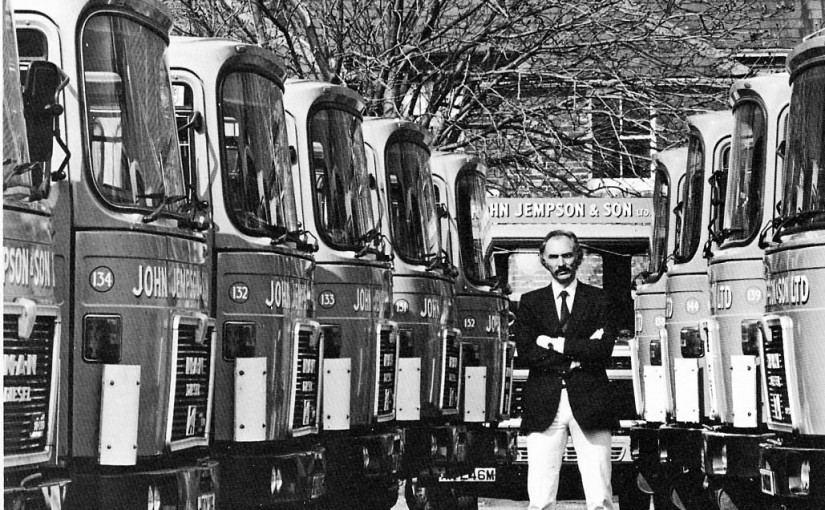The Jempsons of Rye, East Sussex
Who are they and where did they Originate from?
By Roland Jempson Family Historian
(With help from second cousin Bridget Ewing Genealogist)
It was also from Arthur born 1833 and Jane Elizabeth that the other well known branch of the Jempson Family in the Rye Area were descended from. “The Jempsons of the Rye Haulage Company based at Slade Yard..
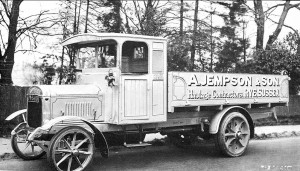
Arthur junior was born 1877 and died in 1955, brother of Henry (born 1868) who married Ruth Palmer in 1901. Arthur started the Haulage business by acquiring from. his Uncle Joshua (Baptised. 1822) and Brother of another Arthur (born 1811) a horse drawn haulage business in the late 19th century, a very different enterprise than the the one we. know now. Horse. & Wagon complemented the Railway’ but did not compete with it. This business was them inherited by Arthur John Jempson (born:. 1904 ) usually just know as John, which we shall call him from now on, (as we already have too many Arthurs!). The business was then mainly conveying Grain, Timber and Bricks to Rye Railway Station and Fish from the Harbour. John Jempson ran four Tip Carts, three Open Vans and one Covered Waggon, plus a Timber Tug to transport felled trees. (You may remember there were Timber Hewers {tree fellers} in the family before). The firm also used a Horse Drawn Landau for passengers, especially for Weddings and Funerals, there was also some Furniture removal work.
From an early age as a boy John assisted his father in the business and in March 1917 John he left school early, because labour was getting harder to get and he was needed to work on a full time basis. This apprenticeship taught him how to load vehicles and get to know the customers. He learned much that was to be of value to him later on when he went into motorised transport. John became fascinated by the motor vehicle as they took over from horse transport more and more through the 1920s.
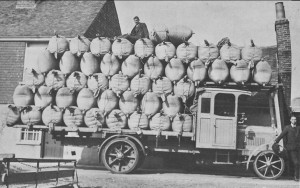
He acquired a second hand Hudson motorcycle and then, in 1924 he at the age of 20, persuaded his father Arthur, to reluctantly lend him £145 for a model T Ford Lorry which he ran. himself as part of the family business. He learned to drive it in 2 or 3 days! Arthur died in 1955. From then on John ran the business entirely on his own.
The motor haulage business was growing was so in 1926 a J Type Thornycroft Lorry was purchased to deliver Tar Barrels , and a second hand. Ford model T was also acquired. Longer journeys were beginning to be undertaken carrying Fruit and General Agricultural Produce to London and other goods such as Fertiliser, Flour and Cattle Food on the return journey.
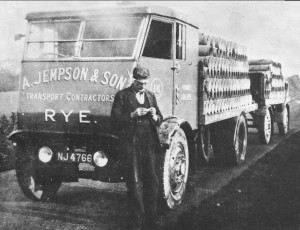
Hops provided a lucrative business in the autumn from Kent and East Sussex to the breweries.
By 1931 Jempson was running two 30 cwt. Ford model A’s, the 5 ton Thornycroft and a Leyland Bull a 43hp. Lorry capable of carrying 8 tons, which John drove himself.
The Jempson business was conducted with the minimum of overheads until 1933 when it moved to its present site at Slade Yard Rye (Behind Undercliiffe)
From 1 January 1932 Arthur Jempson & Sons were legally constituted as a partnership and Profits were shared
As the firm came out of the depression of. the early thirties it had acquired more vehicles of greater carrying capacity, and pneumatic tyres made operations more economical.
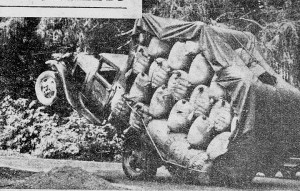
Situated. in Rye was far removed from an ideal operating location for haulage operations, however Jempsons were favoured by there being local manufacturing business’ of concrete products, such as sewer pipes and kerbs, manufactured from locally available raw materials, sand, gravel and aggregates. These concrete products were in great demand in the rapidly expanding London Suburbs. One company supplying these products was Simpson & Co. of Rye Harbour later known as “Spun Concrete” Simpson’s were in trouble with the traffic commissioners over infringements of the 1933 Road and Rail Traffic Act. The upshot was they handed all their vehicles and freight to Jempson’s in l937 rather than contest over 300 summonses that had been issued. Jempson’s paid for these vehicles by deducting 25% of the monthly freight bills.
This was a useful contract as they were often able to come back to Rye with return loads of cement for Simpsons rather than to return empty. Other regular return loads were steel for Rother Iron Works. By the time the 1939 45 war had started, Father Arthur Jempson had retired. Some of Jempson’s vehicles were commandeered by the Ministery of War Transport, but Jempson’s business was classified as essential and drivers were not called up for military service.
Spun Concrete products were now in great demand for Air Raid Shelters, Road Blocks, Dragon’s Teeth and Pill Boxes, for the defence of the country.
After the War came the Labour Government and the 1947 Nationalisation Bill resulted in “JEMPSONS” being “Nationalised.
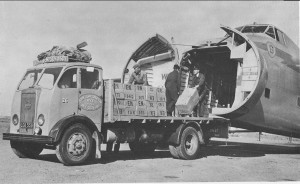
There was compensation and business carried on as usual with John agreeing to be the Manager of a firm he originally owned. He was later moved to Tenterden where he was known as ‘The Rebel’, this new post later turned out to be to his advantage, as it put him in contact with new customers such as Gypsum Mines at Mountfield (now British Gypsum) with whom Jempsons still have contracts in 2010
“Jempson” returned to private ownership in 1954, with 24 vehicles, almost twice. as many as five years earlier, state control had done “Jempsons” a good turn, The valuable new contracts, were to help further growth. John Jempson was now 50, and in another 12 years his son; Jonathon would be ready to joint him in the firm. John had married Ada Ruth Ashby and had two children, Jonathon and Janet. Jonathon, born in 19943 , went to Tonbridge School and Edinburgh University, where he graduated. in commerce.
While on vacation in the 196O he sometimes drove his Fathers lorries, so he started with a practical understanding of’ the business on the road often taking out one of’ the oldest and most difficult to drive, when a driver was unavailable,
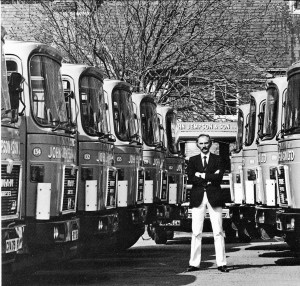
Jonathan started on the clerical slide and then became a. Director, always consulting his father who was them 60. John died in 1981 aged 77 and Johnathan remained solely in charge and is still in command today. The business has grown since he took over and now includes lorries contracted out to British Gypsum, Warehousing, Fork Lift Training, Diesel Sales, Tarpaulins and Cargo Lashing Equipment, besides doing their own Maintenance. Jonathon told. me the other day, that despite the present national financial situation, they are holding their own at the moment and still have. 3 years to go on the British Gypsum Contract. Now you are all wondering’ how I, ROLAND JEMPSON, fit into this extended. family of “JEMPSONS”? I will tell you next month in the third and final instalment of “The Jempsons of Rye”
